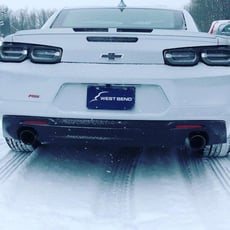
Those of us in the Midwest face many types of driving conditions during the winter months... rain, sleet, ice, hail, and snow, sometimes all on the same day! It can be stressful for experienced adults to navigate these weather conditions, so imagine (or remember) how tough it can be for inexperienced teen drivers.
But that can all change by enrolling your family members in Road America’s Winter Driving School, sponsored by West Bend. The driving course is covered with snow and ice, making for the perfect winter driving experience.
The instructors at Road America teach techniques for handling different winter driving conditions. Those techniques include:
- Skid control and recovery;
- Braking and emergency lane changes; and
- Proper vision skills.
If you can’t attend a class, here are some winter driving tips I’d like to share with you:
1. Identify the type of braking system on your car.
ABS brakes require pressing firmly on the brake pedal and not letting off in slippery conditions (rain or snow). They prevent your wheels from locking in emergencies. On the other hand, standard brakes require you to pump the pedal to avoid tire lockup. Regardless of the braking system on your car, you never want to lock the wheels when braking because this will cause you to lose the ability to steer the car.
2. Keep a safe following distance.
Experts recommend keeping a safe following distance of 8 to 10 seconds. A car traveling at 60 mph covers 88 feet per second, so it can take a vehicle traveling on wet or snow-covered roads 6 to 10 seconds and more than 500 feet to stop.
3. Avoid using cruise control on snow, ice, or water.
While cruise control improves gas mileage and prevents leg fatigue, it’s dangerous to use in slippery conditions. The purpose of cruise control is to keep your tires moving at a consistent speed which you can’t do when driving in tricky conditions. It can cause you to lose control.
4. Avoid sudden maneuvers and do one act at a time.
When driving on snow and ice, “ask” your vehicle to do one thing at a time: brake in a straight line, turn with as little pedal input as possible, and accelerate in a straight line. Drive like you have a cup of water on the dashboard and are trying not to spill it. A sudden maneuver can throw you into an uncontrollable skid because your tires lose traction.
5. Accelerate and decelerate slowly.
This is the best method to maintain adequate traction and avoid skids.
6. Steer where you want the car to go.
When you’re driving, it goes without saying that your eyes are your most important asset. Your eyes tell your hands and feet what to do and can help you maneuver the car to avoid a collision.
7. When in doubt, both feet out.
When things go wrong (a skid or slide), keep your feet off the pedals. Focus on steering the car.
8. Avoid outdriving your headlights.
You need to see at least four seconds in front of your vehicle, so look for a non-reflective landmark and start counting. If you reach the landmark before you reach four seconds, slow down. Your headlights illuminate a distance of about 400 feet; make sure you can stop in that space.
9. If you don’t need to go out, stay home.
And don’t forget these additional winter tips.
- Make sure your tires are properly inflated.
- Make sure your tires have adequate tread.
- To avoid gas line freezing in frigid temperatures, make sure your gas tank is at least half full.
- Make sure your headlights and windshield wipers are in proper working order.
- Consider putting an emergency supply kit in your car.
Not all of us can learn winter driving techniques in a safe, controlled environment. We learn while driving on our local roads and state highways. So, I hope these driving safety tips help you and your loved ones stay safe this winter.
Do you have any winter driving tips you’d like to share? I’d love to hear from you. Please share them in the box below.





